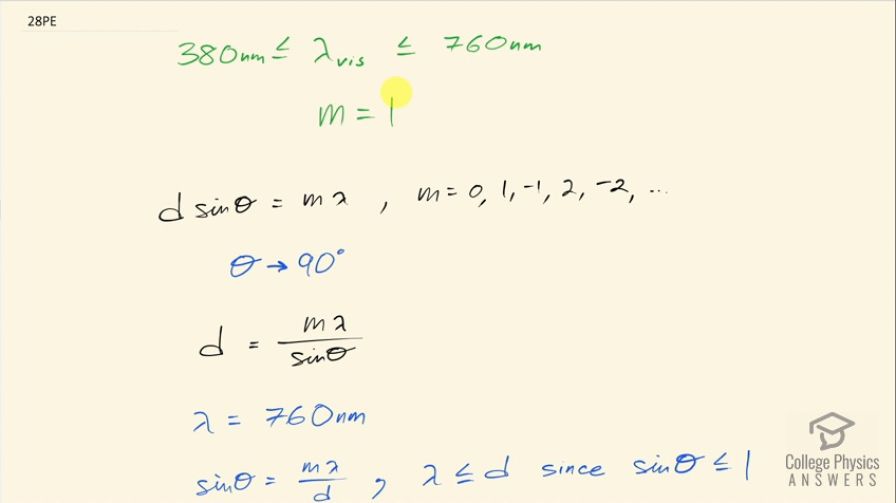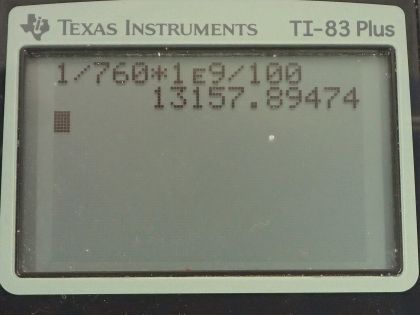Question
What is the maximum number of lines per centimeter a diffraction grating can have and produce a complete first- order spectrum for visible light?
Final Answer
Solution video
OpenStax College Physics for AP® Courses, Chapter 27, Problem 28 (Problems & Exercises)

vote with a rating of
votes with an average rating of
.
Calculator Screenshots
Video Transcript
This is College Physics Answers with Shaun Dychko. A diffraction grating is meant to produce a complete first order spectrum for visible light so first order spectrum means that m equals 1 in this formula for the maxima through a diffraction grating and so this is to say the spacing between each line in the grating times sin of the angle to the maximum equals the order times the wavelength. Now the visible spectrum goes from about 380 nanometers to 760 nanometers say and we want all of these wavelengths to fit on the screen behind the diffraction grating. Now in order for this spectrum to just barely fit, the angle at its most can be 90 degrees because if you imagine you have this diffraction grating all these little lines and some screen that the light's being projected on and the light is coming this direction here and this beam of light which is composed of many different wavelengths— I mean it's visible light... it has a complete spectrum in it— and the wavelengths are going to be projected on the screen with different wavelengths occurring at different angles with respect to this central line here and the maximum possible angle will be 90 degrees 90 degrees strictly speaking would not touch the screen so that's why I have this little arrow here instead of an equal sign but we are going to say Θ equals 90. Okay! So solving for d means we divide both sides by sin Θ and then we have d equals mλ over sin Θ. Now d is not the answer to our question d is the space between each line but we can convert it into lines per centimeter at the end. Now what should the wavelength be? Now we want to minimize d because that will give us the maximum number of lines packed into a centimeter by reducing the distance between each line. So with that in mind, we might think about using 380 nanometers since that's the minimum value for the wavelength but if we did that then this 760 nanometer color would not fit on the screen because if you were to rearrange this formula to solve it for sin Θ by dividing both sides by d you see that sin Θ is mλ over d and the maximum possible value for sin Θ is 1 because if you were to draw a graph of sin Θ its graph looks like this the range of sin Θ is from 1 down to negative 1 so sin Θ can never be more than 1. Okay so that's a graph of y equals sin Θ. So the maximum possible value of sin Θ is 1, which is to say that this numerator has to be less than or equal to the denominator so this fraction has to be less than or equal to 1 and m is 1— that's pretty clear because it's talking about a first order spectrum— and so that means that λ has to be less than or equal to d and that means we can't make λ too big. So d is going to be equal to λ as it turns out since when you plug in for m that's 1 and sin of 90 is also 1 so d equals λ but if we had chosen 380 nanometers then we would have a scenario where λ, which can be up to 760, could be more than d; if we took d to be 380 nanometers then we can find a scenario where well, we have a wavelength that's 1 in that in which case this fraction will be more than 1 and that will break everything because sin Θ can't be more than 1. Okay! So 760 is the wavelength to choose. And then we convert this d into lines per centimeter so we know there's one line for every 760 nanometers—that's what d means— and then we multiply that by 1 times 10 to the 9 nanometers per meter and now we have lines per meter and then convert the lines per meter into lines per centimeter by multiplying by 1 meter for every 100 centimeters and now we have 13200 lines per centimeter, where I have rounded this number to three significant figures.
